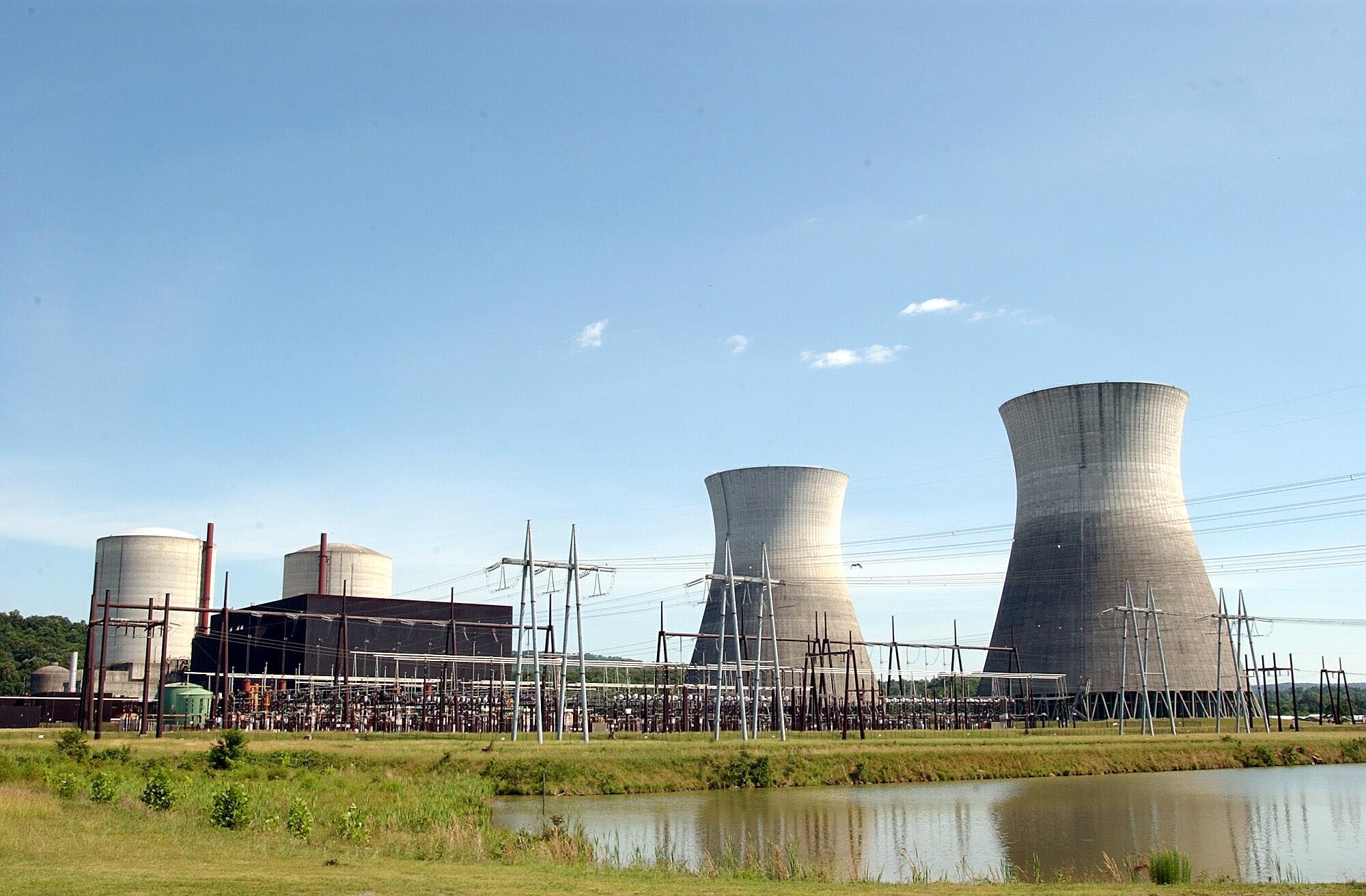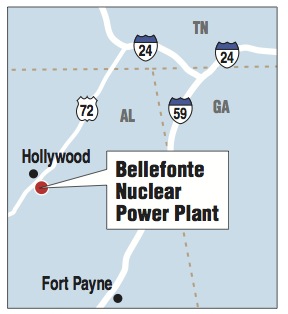Bellefonte at a glanceLocation: On the Tennessee River in Hollywood, Ala.Size: 1,600 acresExisting reactors: Two unfinished Babcock & Wilcox pressurized water reactors, started in 1974 but never completedInvestment: More than $6 billion of capital, maintenance and interest costs spent so farCompletion costs: Preliminary estimates of $8 billion for existing reactorNew reactors: The site was once proposed to be the first for the Westinghouse AP 1000 designStaff: About 160 employees and contractors, down 400 from this summerConstruction starts and stops1974 - Construction permit issued and building begins1985 - Construction halted on Unit 2, then 55 percent complete1988 - Construction halted on Unit 1, then 88 percent complete1992 - Engineering work resumed to prepare for restart of construction.1994 - Stone & Webster estimates finishing Bellefonte would cost $2.6 billion. Engineering work halted1996 - TVA studies options of converting plant to combined-cycle natural gas but drops plans two years later2001 - Texaco proposes using Bellefonte as site for coal gasification plant and Chattanooga financier Franklin Haney offers to finance completion of Bellefonte as nuclear plant2002 - Texaco drops proposal and TVA turns down Haney offer2005 - Nustart energy coalition picks Bellefonte as site for Westinghouse AP 1000 nuclear plant. TVA withdraws permit for original plant2006 - TVA sells steel tubing, pipes for scrap metal from original units. Other equipment transferred to other plants2008 - TVA reverses itself and decides to revive original Bellefonte units.2009 - Nuclear Regulatory Commission reinstates construction permit in terminated status2013 - TVA cuts 400 of the 560 jobs at Bellefonte, suspending most engineering work, due to slowdown in power demand2013 - Private investment group assembled by Franklin Haney proposes private financing deal to complete Bellefonte by 2021. TVA reviews offer
HOLLYWOOD, Ala. - The 500-foot high, hyperboloid-shaped cooling towers rise over the rolling hills along the Tennessee River, shaping the physical and potentially the economic landscape of Northeast Alabama.
The twin towers and the high-voltage lines that crisscross the unfinished Bellefonte Nuclear Power Plant stand as the most visible symbols of one of America's largest unfinished construction projects- and perhaps the last of a generation of nuclear plants of their type.
"We want to see some steam coming out of those cooling towers," Jackson County Economic Development Director Goodrich "Dus" Rogers said last week at the inaugural meeting of an energy advisory board studying the future power plans for the Tennessee Valley Authority. "We need to do what makes the best business sense, but I know we need the jobs and economic development that would come from having Bellefonte produce power."
But the construction cranes and crews that erected most of the Bellefonte Nuclear Power Plant in the 1970s and 1980s left more than 25 years ago. TVA suspended work when energy demand fell short of expectations and that slowdown in power growth has intensified over the years.
Since mothballing the plant in 1988, TVA has pursued options from using Bellefonte to make nuclear bomb material, to converting the plant to other forms of energy, to simply junking the plant and selling its component parts. When TVA briefly decided to scrap the original plant eight years ago, TVA also flirted with the idea that Bellefonte should be the test site for the next generation of Westinghouse nuclear plant designs, using the switch yards, cooling towers and other facilities from the original Babcock and Wilcox designed plant.
With the exception of a couple of years, TVA has maintained the original plant for future generation of nuclear power and its supporters insist Bellefonte is still one of the best nuclear plants TVA ever built, even if it is yet to generate any power.
Since construction began in 1974, TVA has spent more than $6 billion to design, build, maintain, analyze and finance work on the two 1,260-megawatt nuclear reactors at Bellefonte. The reactors are the biggest in TVA's fleet and, if completed, the two unit could supply the electricity needs of 750,000 homes.
"This is probably the most studied power plant in the country," said Bill McCollum, TVA's former chief operating officer who is working as a consultant for a private equity group pushing TVA to finish Bellefonte. "We know what is there and have a pretty good idea what it will take to finish it."
But nuclear power critics insist that when TVA decided in 2006 not to finish Bellefonte and began gutting the unfinished plant, it gave up on the plant and that decision shouldn't be reversed.
"This is like a zombie that just won't die," said Garry Morgan, a Scottsboro, Ala., leader in the Bellefonte Efficiency and Sustainability Team (BEST) who has fought the nuclear plant through its history. "I've not always been popular with some of my neighbors who want the jobs from operating Bellefonte. But it just doesn't make either economic or environmental sense to go forward with a 1960s design plant that has been gutted of some of its key safety equipment."
Reversals of fortune
Morgan even questions the legality of nuclear regulators restoring TVA's construction permit here after TVA decided in 2006 to give up on the unfinished plant to pursue other options at the site. Rather than put more money into finishing the original plant design, TVA agreed to join with other utilities and engineering companies to pursue a newer and simpler plant design at Bellefonte by building the entirely new AP1000 plant. For two years when TVA was planning on building the AP1000, TVA gutted some of the original plant, transferring $49 million of equipment from Bellefonte to other TVA coal and nuclear plants and selling another $16 million of stainless steel pipes and tubes to scrap metal vendors.
But only two years later, TVA reversed itself yet again when the AP1000 design looked to be more expensive than finishing the original units. Last year, spent $182 million on engineering, assessment and maintenance work at Bellefonte and was moving toward completing the first unit sometime between 2018 and 2020. TVA nuclear construction and engineering crews were scheduled to shift from completing the Unit 2 reactor at Watts Bar, projected to finish in 2015, to finishing work on the first reactor at Bellefonte top allow an orderly sequence of nuclear plant construction.
Those plans went awry again when the recession and its aftermath, combined with intensified consumer conservation and energy efficiency moves, cut TVA's power demand by a record amount. For the first time in its 80-year history, power sales by TVA are projected this year to fall for the fourth consecutive year.
"We don't expect to get back to the power peak that we had in 2007 (prior to the Great Recession) until sometime in the middle of the next decade," said Dr. Joe Hoagland, vice president and chief technology officer for TVA.
Falling power demand
Hoagland, who is helping two groups of TVA stakeholders review TVA's future power forecasts, said the shift in power demand is one of the most significant changes ever for the electric power industry. Electricity consumption historically grew through most of TVA's history by 3 to 4 percent a year, requiring TVA to build another power generating unit almost every year. But TVA now expects long-term power consumption to rise less than 1 percent a year and could even be flat or decline if consumers continue to shift to more efficient electric appliances or move to more self-generated power for some or all of their energy needs.
"There's a paradigm shift that we need to recognize and it won't take much change in technology or prices to dramatically alter the utility industry," said Dr. Stephen Smith, executive director for the Southern Alliance for Clean Energy and a member of the Regional Energy Resource Council.
A 2009 study done, in part, by TVA Director and Georgia Tech Professor Marilyn Brown estimates that an aggressive promotion of energy efficiency and conservation could cut electricity consumption between 30 and 75 percent, avoiding the need to build most new power plants.
The new energy council began considering such shifts last week during its first meeting here in the shadow of the unfinished Bellefonte plant. The council's recommendations - and ultimately any TVA board decision - will determine the fate of Bellefonte.
New alternatives
Bellefonte also is facing new competition from another new nuclear design and a new push for completion from outside financiers.
While TVA has delayed completion of the Bellefonte plant, nuclear engineering companies have developed plans for a smaller nuclear reactor that backers claim is simpler, safer and could be built more in accordance with incremental increases in power demand. The major components of the small modular reactor also could be built in a factory, shipped to the plant site and installed underground. Such a process, if standardized, could limit the variations in design of the existing reactors and allow for standardized training and installation programs. The units also are small enough to allow for a design that is safer than its bigger counterparts.
"The SMRs (small modular reactors) offer a lot of advantages in providing us incremental power in a way that may better conform with our future growth expectations," TVA President Bill Johnson said following a recent address to the Chattanooga Rotary Club.
TVA is developing plans to build a small modular reactor on the Clinch River in Oak Ridge. After Watts Bar, TVA is likely to either pick the small modular reactor project or Bellefonte as the next source of nuclear power generation for the next decade.
Johnson said Bellefonte is an asset that will remain for TVA and could be completed later for future generation.
But a private investment group organized by financier Franklin Haney, formerly of Chattanooga, wants TVA to move next to finish Bellefonte so the project can qualify for up to $2 billion of federal tax credits that will expire if the plant is not operational in the next eight years. Bellefonte would be more sustainable and could replace many of the aging coal power plants TVA will need to either scrub or shut down to meet air pollution control requirements.
The investment banking firm Credit Suisse estimates both of the Bellefonte units could be finished for another $11 billion, which is only about half the expense of some other proposed new nuclear power plants. Former TVA Chairman Dennis Bottorff is urging TVA to finish Bellefonte and is part of the investment group that could help fund the project for TVA under a leasing arrangement that would give TVA the power and operating control of the plants without having to put up its own cash in advance to pay to finish the units.
"There is a real opportunity here that TVA needs to consider," Bottorff said during a presentation of the plan to Tennessee's U.S. senators last month.
With a $30 billion debt ceiling less than $5 billion above its current borrowing, such outside financing could be key if TVA wants to move aggressively to finish the plant without surpassing its debt ceiling, and with the private financiers still able to price the deal before federal production tax credits for new nuclear power generation expire in 2021.
Johnson said TVA is still reviewing the financing proposal for Bellefonte and other power plants, although he questioned some of the group's numbers. In a preliminary presentation to members of Congress, Johnson listed the cost of completing just one unit at Bellefonte, including financing costs, at $8.1 billion.
"There are a lot of factors to consider," he said.
Here is Alabama, TVA is still being urged to finish Bellefonte.
U.S. Sen. Jeff Session, R-Ala., said he was "deeply disappointed" by the slowdown in work at the plant this summer.
"In my view, the fundamentals of completing Bellefonte remain positive over the long-term.," Sessions said in a statement this summer. "TVA has made a firm commitment to the people of North Alabama to complete Bellefonte... and I remain convinced that this pivotal energy investment must be completed."
Contact Dave Flessner at dflessner@timesfreepress.com or 757-6340


